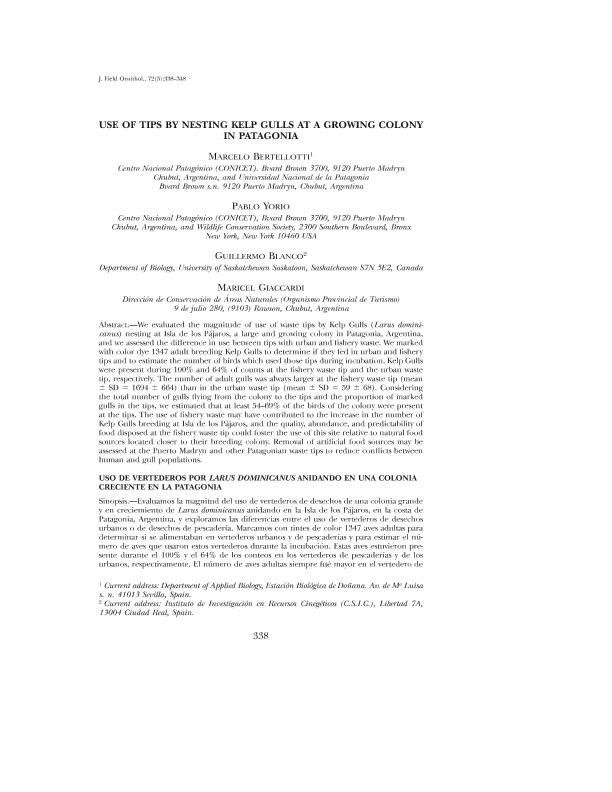Mostrar el registro sencillo del ítem
dc.contributor.author
Bertellotti, Néstor Marcelo

dc.contributor.author
Yorio, Pablo Martin

dc.contributor.author
Blanco, Carlos Guillermo

dc.contributor.author
Giaccardi, Maricel
dc.date.available
2020-03-13T18:54:56Z
dc.date.issued
2001-12
dc.identifier.citation
Bertellotti, Néstor Marcelo; Yorio, Pablo Martin; Blanco, Carlos Guillermo; Giaccardi, Maricel; Use of tips by nesting Kelp gulls at a growing colony in Patagonia; Association of Field Ornithologists; Journal Of Field Ornithology; 72; 3; 12-2001; 338-348
dc.identifier.issn
0273-8570
dc.identifier.uri
http://hdl.handle.net/11336/99538
dc.description.abstract
We evaluated the magnitude of use of waste tips by Kelp Gulls (Larus dominicanus) nesting at Isla de los Pajaros, a large and growing colony in Patagonia, Argentina, and we assessed the difference in use between tips with urban and fishery waste. We marked with color dye 1347 adult breeding Kelp Gulls to determine if they fed in urban and fishery tips and to estimate the number of birds which used those tips during incubation. Kelp Gulls were present during 100% and 64% of counts at the fishery waste tip and the urban waste tip, respectively. The number of adult gulls was always larger at the fishery waste tip (mean ±SD = 1694 ± 664) than in the urban waste tip (mean ± SD = 59 ± 68). Considering the total number of gulls flying from the colony to the tips and the proportion of marked gulls in the tips, we estimated that at least 54–69% of the birds of the colony were present at the tips. The use of fishery waste may have contributed to the increase in the number of Kelp Gulls breeding at Isla de los Pa´jaros, and the quality, abundance, and predictability of food disposed at the fishery waste tip could foster the use of this site relative to natural food sources located closer to their breeding colony. Removal of artificial food sources may be assessed at the Puerto Madryn and other Patagonian waste tips to reduce conflicts between human and gull populations.
dc.description.abstract
Evaluamos la magnitud del uso de vertederos de desechos de una colonia grande y en crecimiento de Larus dominicanus anidando en la Isla de los Pájaros, en la costa de Patagonia, Argentina, y exploramos las diferencias entre el uso de vertederos de desechos urbanos o de desechos de pescadería. Marcamos con tintes de color 1347 aves adultas para determinar si se alimentaban en vertederos urbanos y de pescaderías y para estimar el número de aves que usaron estos vertederos durante la incubación. Estas aves estuvieron presente durante el 100% y el 64% de los conteos en los vertederos de pescaderías y de los urbanos, respectivamente. El número de aves adultas siempre fué mayor en el vertedero de pescadería (promedio 5 1694, SD 5 664) que en el vertedero urbano (promedio 5 59, SD 5 68). Considerando el número total de aves volando de la colonia a los vertederos y la proporción de aves marcadas en los vertederos, estimamos que al menos el 54–69% de las aves de la colonia estaba presente en los vertederos. El uso de los desechos de pescadería puede haber contribuído al aumento en el número de aves anidando en la Isla de los Pájaros. La calidad, abundancia, y predictabilidad de alimentos disponibles en el vertedero de pescadería podría estimular el uso de esta localidad relativo a las fuentes de recursos alimenticios localizados cercanos a su colonia reproductiva. La remoción de fuentes artificiales de alimentos pudiera llevarse a cabo en el Puerto Madryn y en otros vertederos de Patagonia para reducir conflictos entre poblaciones humanas y de las gaviotas.
dc.format
application/pdf
dc.language.iso
eng
dc.publisher
Association of Field Ornithologists
dc.rights
info:eu-repo/semantics/openAccess
dc.rights.uri
https://creativecommons.org/licenses/by-nc-sa/2.5/ar/
dc.subject.classification
Ecología

dc.subject.classification
Ciencias Biológicas

dc.subject.classification
CIENCIAS NATURALES Y EXACTAS

dc.title
Use of tips by nesting Kelp gulls at a growing colony in Patagonia
dc.title
Uso de vertederos por larus dominicanus anidando en una colonia creciente en la Patagonia
dc.type
info:eu-repo/semantics/article
dc.type
info:ar-repo/semantics/artículo
dc.type
info:eu-repo/semantics/publishedVersion
dc.date.updated
2020-02-11T17:52:56Z
dc.identifier.eissn
1557-9263
dc.journal.volume
72
dc.journal.number
3
dc.journal.pagination
338-348
dc.journal.pais
Estados Unidos

dc.journal.ciudad
Kansas
dc.description.fil
Fil: Bertellotti, Néstor Marcelo. Consejo Nacional de Investigaciones Científicas y Técnicas. Centro Científico Tecnológico Conicet - Centro Nacional Patagónico; Argentina
dc.description.fil
Fil: Yorio, Pablo Martin. Consejo Nacional de Investigaciones Científicas y Técnicas. Centro Científico Tecnológico Conicet - Centro Nacional Patagónico; Argentina
dc.description.fil
Fil: Blanco, Carlos Guillermo. University of Saskatchewan; Canadá
dc.description.fil
Fil: Giaccardi, Maricel. Provincia de Chubut. Dirección de Conservación de Áreas Naturales; Argentina
dc.journal.title
Journal Of Field Ornithology

dc.relation.alternativeid
info:eu-repo/semantics/altIdentifier/url/https://bioone.org/journals/journal-of-field-ornithology/volume-72/issue-3/0273-8570-72.3.338/USE-OF-TIPS-BY-NESTING-KELP-GULLS-AT-A-GROWING/10.1648/0273-8570-72.3.338.short
dc.relation.alternativeid
info:eu-repo/semantics/altIdentifier/doi/http://dx.doi.org/10.1648/0273-8570-72.3.338
Archivos asociados
